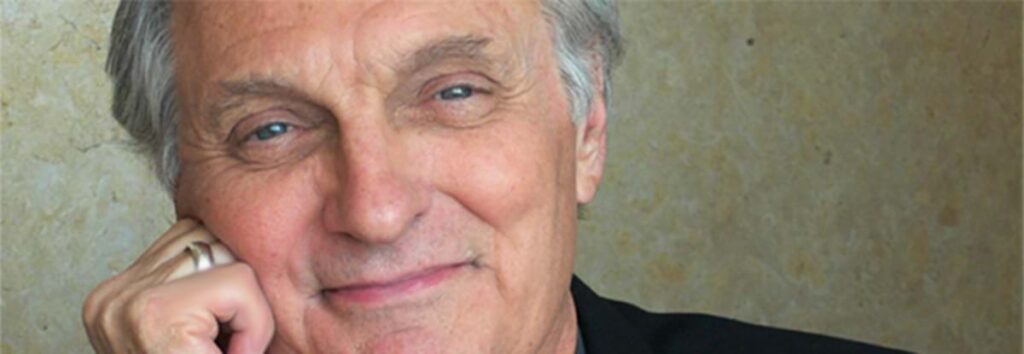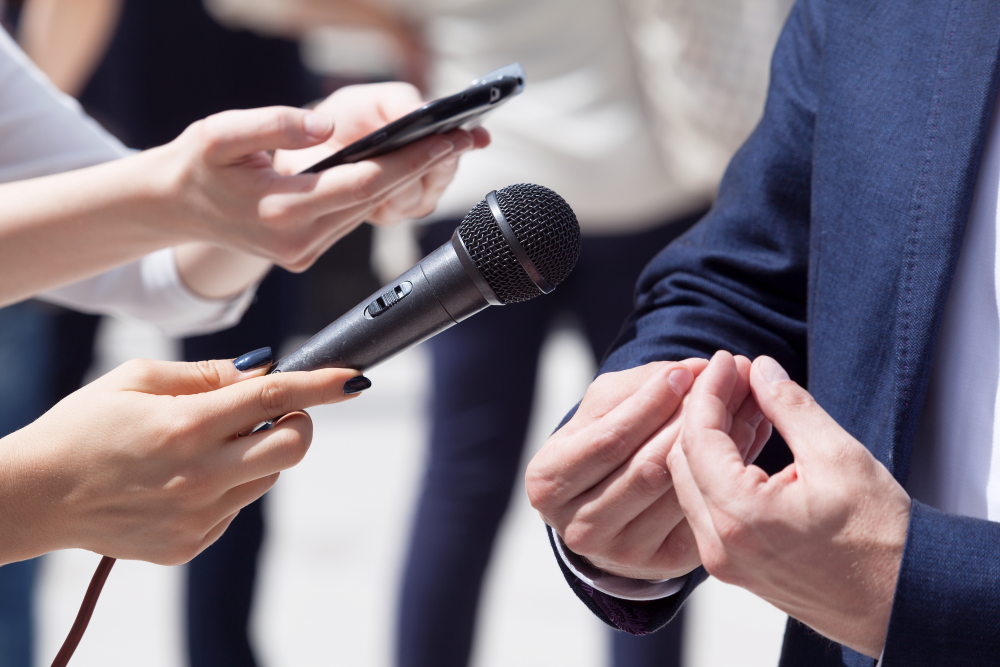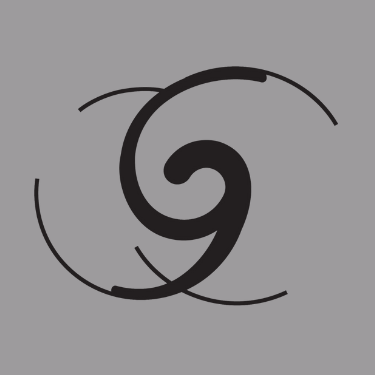Discovering a Common Language with Alan Alda
The actor, writer, and science advocate educates scientists in the elusive art of communication.
Published August 1, 2015
By Kellie M. Walsh
Academy Contributor

All he’d said was “Oh,” but I could hear in the shape of the vowel that the smile on his face was evaporating. I’d given Alan Alda a terrible answer, exactly the type of answer he has worked so hard to train out of others.
For more than 20 years, Alda, like The New York Academy of Sciences, has been on a mission to get people talking to one another. While the Academy brings scientists and non-scientists from different disciplines, sectors, and communities together through common goals and initiatives, Alda focuses on bringing them together through a common language.
As Visiting Professor at the Alan Alda Center for Communicating Science at Stony Brook University, he uses improvisational techniques and theater games to train scientists to distill and translate their work into language that officials, media, funders, the public, and scientists of other disciplines can all understand. This interest in aiding the sciences through the arts, in fact, inspired the founding of the Center for Communicating Science in 2009; it was renamed in his honor in 2013.
Alda’s objective is to transform scientists not into actors but rather into comfortable, empathetic conversationalists able to clearly express their work to anyone and everyone—and, consequently, help advance it forward. He has also hosted several notable science documentary series for public television; is an award-winning actor, writer, and director; and has received numerous science communications awards, including the National Science Board’s Public Service Award (2006), the Scientific American Lifetime Achievement Award (2013), the AAAS Kavli Science Journalism Award for The Human Spark (2010), and the Council of Scientific Society Presidents’ Carl Sagan Award for Public Understanding of Science (1998).
Talking Shop about Communications
In anticipation of our phone call, I’d prepared to talk about Alda’s long and credentialed career. I’d prepared to talk shop about communications. I’d even prepared a two-sentence introduction that I’d practiced reading aloud, hoping to convey to Alda that his communications work and mine paralleled in notable ways. I wanted to show that we spoke the same language.
I hadn’t prepared for him to actually be interested.
I’d just finished my introduction, explaining I was the then Associate Director of Web Content and Development for the Academy, which was a long way of saying that I helped people communicate online. Alda jumped on my last word so quickly I almost didn’t hear him ask, “How?” As in, how in my work do I help people communicate online?
It was a reasonable question; one I’d opened the door to even. Yet I bumbled. I stammered out a staccato of half-sentences, then topped them off with jargon. Rather than speaking his language, I found myself talking straight over his head. Without meaning to, I’d answered his interest and curiosity by shutting the door in his face.
Mine wasn’t the first disappointing answer Alda had ever encountered, however: during his 11-year tenure as host of Scientific American Frontiers, for one, Alda had interviewed hundreds of scientists, many whose thoughts he’d found stuck inside their own minds. But rather than allow his interview subjects to deflect, obfuscate, or drone through a rote script, he discovered that the way to break through this obstacle was to keep tapping interviewees with questions until their shells finally cracked.
Effective Interview Tactics

“In most interviews,” explains Alda, “you already know the answer to the questions. I didn’t know what the questions were; nor did I know what the answers were. I just wanted to understand what their work was. And if I didn’t understand it, I’d badger them until I did.”
Alda’s persistence and desire to learn often helped his interviewees overcome both their nerves and their “curse of knowledge,” the cognitive bias that makes it difficult to think or talk about a familiar subject as if from a position of unfamiliarity. “They lost all interest in talking to the camera,” he says, “and really wanted me, personally, to understand it. It was just me and them. Their humor came out, their curiosity. It was an intimate interaction. That’s what we want and what we work hard to get scientists to do when they communicate. We invite them to tell stories, to let themselves be in the stories. Because that’s what audiences will respond to.”
Of course, that’s easy for Alda to say: he’s a famous, quick-witted raconteur with a smile you can hear through a phone line. Yet he says he, too, must consciously work at interaction, especially in unfamiliar social settings. “We often shrink from human contact because we feel naked out there sometimes,” he says. “I mean, I’m not comfortable with cocktail parties. I have to use what I’ve learned in communication to be comfortable, to realize that the person I’m talking to has probably the same uncertainty about the situation that I do.”
Making that Connection
That consideration of his audience’s state–that empathy–is how Alda transforms superficial small talk into meaningful communication. The key, he says, is to make an active effort “to connect with the people you’re talking to or writing for. What are they thinking when you say the first thing you’re saying? Who are they? What do they know already? That old thing of knowing your audience–it’s not just knowing your audience; it’s connecting to your audience. To be there with them in the same room.”
Alda means that last bit both literally and figuratively: to connect, we must recognize–relish even–that we are all allies, social animals with an innate desire to understand and to be understood. In this way, he says, art informs life. “You can’t achieve what you’re going onstage for unless you can make real contact with the fellow players,” he says.
“That’s the essence of what we’ve found about communication: that connection, that awareness of the other person, immediately relaxes you. When you address the audience directly, they become your fellow players. And there’s a big difference between thinking of them as your fellow players and thinking of them as people who are judging you…I’ve had so many young scientists say, ‘I overcome my fear by looking over the heads of the audience.’”
“[But] once you get used to the fact that they’re your playmates and not your adversaries, you overcome your fear by looking them in the eye. By enjoying their company. Then you actually can develop–it seems hard to believe–but you actually can develop a personal relationship with a group of strangers.”
An Experiential Learning Process
Breaking through our natural aversions to vulnerability to develop such relationships, however, takes practice. “It’s not an intellectual understanding,” says Alda. “It’s an experiential learning process,” one he says often requires fighting against lessons most scientists have had drilled into them.
To facilitate objectivity, he explains, “you have emotion trained out of you when you’re writing science for other scientists in your field.” But communicating science to broader audiences requires the opposite approach because, as he says, “people like me, ordinary people, rely on story and emotion.” Thus, the Alda Center aims to redesign the way scientists are educated, placing special emphasis on training science and healthcare graduate students while they’re still learning their fields of study so “when they leave as professional scientists, they’ll be good communicators as a matter of course.”
Alda cites Nobel Prize-winning physicist Richard Feynman, whom he played in QED on Broadway, as the preeminent example of a successful science communicator. “He didn’t wave his arms and get crazy about it,” he says, “[yet] he could talk in the most loving way about nature in all its complexity, and you could really follow him.” Alda wants the same for his workshop students: for them to leave able to use “everyday terms for complex things” in a way that is both compelling and easy to understand. So compelling and easy, perhaps, that even a child could understand.
The Flame Challenge
Since 2012, Alda and the Alda Center have posed to scientists an annual challenge: to explain (in words, graphics, or video) a common but complex scientific phenomenon in a manner acceptable to the average 11-year-old. Inspired by a disappointing childhood experience in which a teacher answered a young Alda’s curiosity with cool jargon, the challenge (called The Flame Challenge, for its first-year topic) requires scientists to think deeply about how best to engage this unique, likely unfamiliar audience.
This year’s challenge question: What is sleep? “The Flame Challenge is a great exercise for scientists because it is all about focusing on the people you’re talking to–in this case, 11-year-olds,” says Elizabeth Bass, Director of the Alda Center, via email. “What do they know? What do they care about? How can I express something important and complex in ways that will connect with them?”
That Bass’ questions echo Alda’s is unsurprising: their individual and collective goals are one and the same. “Connecting with your audience–trying to read their minds, in a sense–is at the heart of communication for Alan Alda and for the Alda Center at Stony Brook,” she says. “So the Flame Challenge fits perfectly with our approach.”
Challenge submissions are vetted, then released for judging to an international pool of tens of thousands of middle-school students. Winning entries are announced at the World Science Festival in New York City, which occurred in late May.
The challenge fosters the development not only of current scientists but of potential future scientists and science enthusiasts as well.
An Unconventional Approach
“The Flame Challenge was aimed at scientists,” Bass says, “but kids and teachers loved the contest right from the start. The kids get to judge the work of adults, and that doesn’t happen very often. They really appreciate being taken seriously. Also, kids get to hear different attempts at answering the same question. It’s a good way to learn. It helps them see that science isn’t a stock set of known facts: it’s a way of trying to know things.”
This unconventional approach to trying to know things underlies both the Alda Center’s mission and Alda’s vast successes as an actor, writer, director, teacher, and science and communications advocate.
And, it comes as no surprise, as a conversationalist. In our phone call, Alda was friendly, familiar, and disarmingly charming; the discussion flowed, with one exception, smoothly. Yet, as I put down my script to listen, I couldn’t help but feel quietly mortified. I’d allowed my nerves to trip me into curse-of-knowledge jargon and deflection, forcing me to work twice as hard to re-build the easy rapport I had disrupted. My one comfort was knowing, or at least hoping, that he was working as hard to make a connection as I was.
Kellie M. Walsh is a freelance writer, web producer, and content strategist in New Jersey.
This story originally appeared in the summer 2015 issue of The New York Academy of Sciences Magazine.
Also read: From Successful Actor to Impactful Science Advocate
